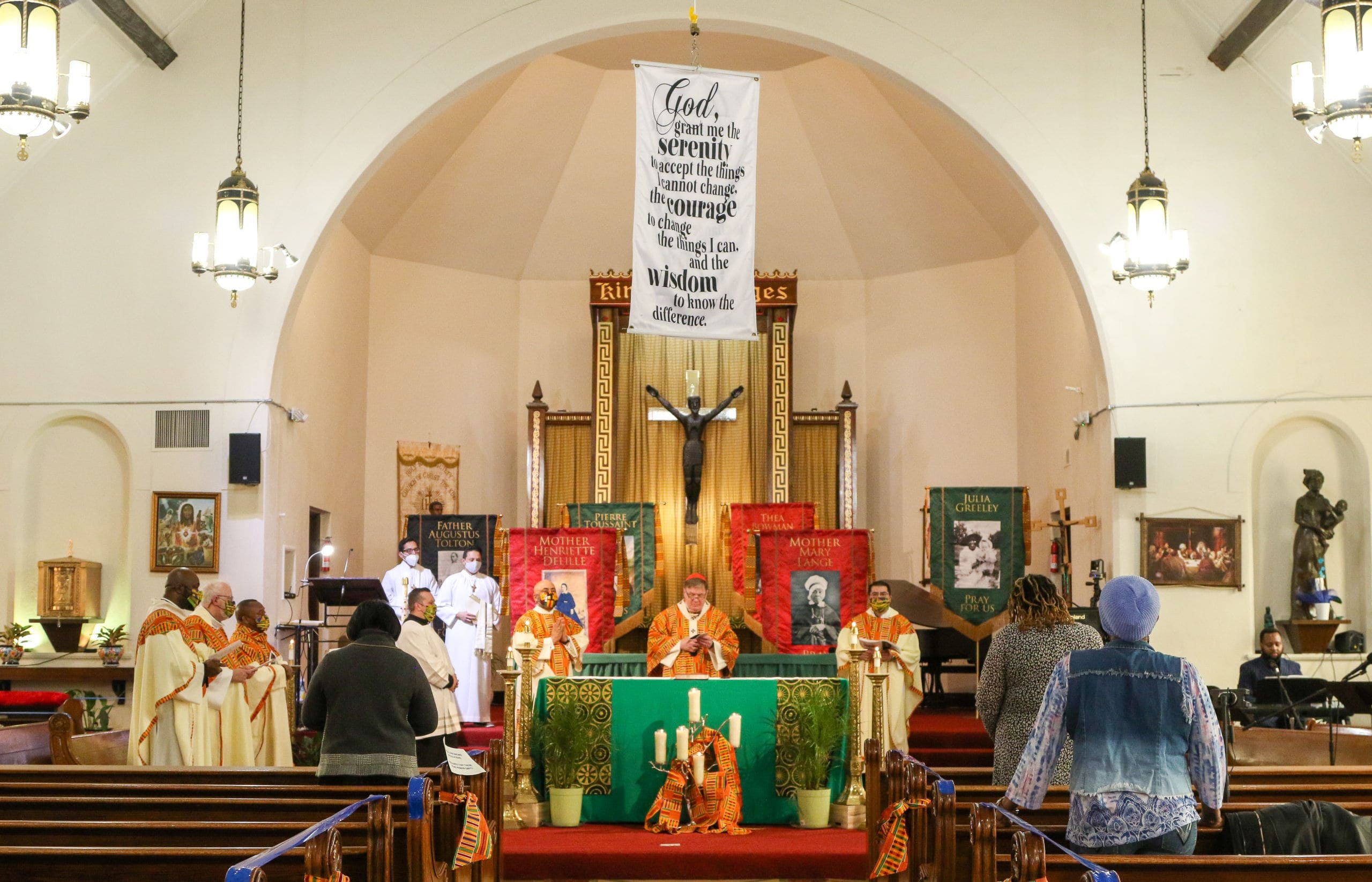Black History Month: Haitian communities in the Archdiocese of Newark
In 1989, Sister Thea Bowman visited Seton Hall University and addressed the American Bishops Conference meeting there. In her talk she spoke of the experience of the Black Catholics in the United States. At the end, the bishops joined her in singing “We shall Overcome.”
“What does it mean to be Black and Catholic? It means that I came to my church fully functioning. That doesn’t frighten you, does it? I came to my church fully functioning. I bring myself, my black self, all that I am, all that I have, all that I hope to become, I bring my whole history, my traditions, my experience, my culture, my African American song and dance and gesture and movement and teaching and preaching and healing and responsibility as a gift to the Church.” — Excerpt from Sister Thea to the American Bishops, June 17, 1989
Archbishop Thomas Walsh (born: 1873, died: 1952, bishop and archbishop of Newark: 1928-1952) was aware of the “Great Migration” of African Americans from the southern states to the north, particularly the northeast and the middle west. He established three personal parishes for African Americans: Queen of Angels (1930) in Newark, Christ the King (1930) in Jersey City, and Saint Peter Claver (1932) in Montclair. The main impetus for these parishes came from groups of African American Catholic women who continually petitioned for better pastoral care. When Walsh administered the sacrament of Confirmation at Christ the King in 1932, the number of confirmands was 223. By 1937, the number of parishioners reached 1,675. Queen of Angels flourished. Walsh baptized the 1,000th convert there in 1935. By the end of 1937, the total number of parishioners was 2,000.1
Over the years, many African Americans moved from the cities and joined parishes throughout the Archdiocese. Queen of Angels in Newark declined in numbers and closed. However, Saint Peter Claver in Montclair and Christ the King in Jersey City continue to serve the African American community and also recently arrived immigrants, many from Haiti and from Spanish-speaking countries.
In recent years, the United States has seen an upsurge in Haitian immigration. Official U.S. immigration statistics record fewer than 4,500 Haitian immigrants in the period 1951-1960, but about 34,500 in the following ten years. By the decade of 1991-2000, the figure topped 179,600. In addition to those admitted as legal immigrants, tens of thousands of Haitians have, at various times, attempted to gain admission to the United States as refugees. As of 2000, according to United States government estimates2, about 76,000 Haitians lived within the borders of the United States as undocumented migrants.
Haitian immigration to the United States remained negligible until the latter half of the 20th century; in fact, 1932 is the first year Haitians were counted separately in immigration statistics, and fewer than 200 arrived during the remainder of that decade.
Haitian Immigration to the United States
| 31-40 | 41-50 | 51-60 | 61-70 | 71-80 | 81-90 | 91-00 | 01-10 |
| 200 | 1,000 | 4,442 | 34,499 | 56,335 | 138,379 | 179,644 | 178,000 |
During the early 1960s and the 1970s, many Haitians migrated to the United States to escape the oppressive conditions during the dictatorships of François “Papa Doc” and his son Jean-Claude “Baby Doc” Duvalier. Political unrest, economic strains, and natural disasters have supplied additional reasons for people to emigrate.3 According to the 2010 United States Census, there were 881,488 Haitian Americans living in the United States.
Following Florida, New York, and Massachusetts, New Jersey has the fourth largest Haitian population, 49,340. The largest Haitian communities are in Irvington, (6,090), Orange (3,512), East Orange, and Newark. Other cities with significant Haitian populations are Elizabeth, Bayonne, and Jersey City. There is also a growing population in the suburbs of Essex and Union Counties in Roselle, West Orange, Maplewood, and Union.4
Of the Haitians in New Jersey, 72 percent live within the archdiocese of Newark. According to Pew studies, 57 percent of Haitians are Catholic, but the number of practicing Catholics is lower. Active proselytizing among Haitians at home and in the United States is reducing this number.5
As the Haitian migration grew, priests form Haiti came to the archdiocese as adjunct priests and others were incardinated into the archdiocese. In addition, diocesan clergy learned Creole and ministered to the Haitian community as well. Today, Mass is celebrated in Creole in six parishes that include large Haitian communities: Holy Spirit/Our Lady Help of Christians in East Orange, Holy Rosary/Saint Michael in Elizabeth, St. Leo in Irvington, Saint Patrick and Assumption/All Saints in Jersey City, Saint Peter Claver in Montclair, and Our Lady of Mount Carmel in Orange.
Most parishes with a large Haitian community also have immigrant communities from other cultures. This is difficult for many Haitians who feel as though they do not have “their own” church. Often, parishes with a Haitian population celebrate the Sunday liturgy in three, even four languages.
Haitian Population in the Archdiocese of Newark
| NJ | Bergen | Essex | Hudson | Union | RCAN | ||
| 2010 | 58,816 | 2,089 | 22,452 | 2,769 | 15,301 | 42,611 | |
| 2017* | 63,687 | 1,817 | 23,683 | 3,469 | 14,788 | 43,757 |
Decennial dates are Official United States Census
*United States Census Bureau Estimate
Msgr. Robert J. Wister, Hist.Eccl.D. is a retired professor of church history at Immaculate Conception Seminary School of Theology, Seton Hall University, and writes historical articles for the publications of the Archdiocese of Newark.



